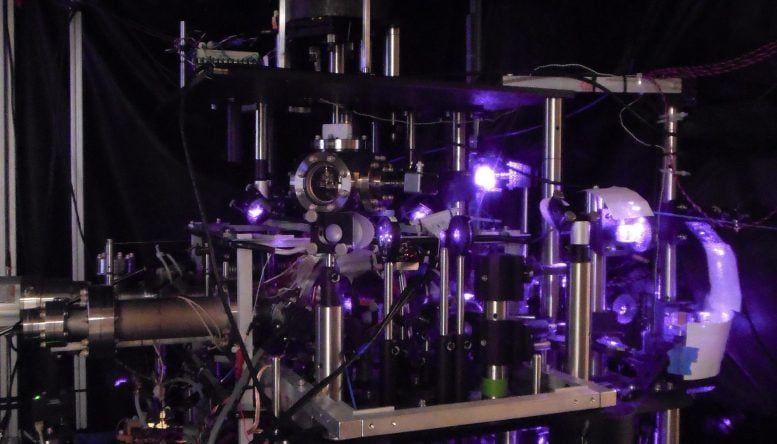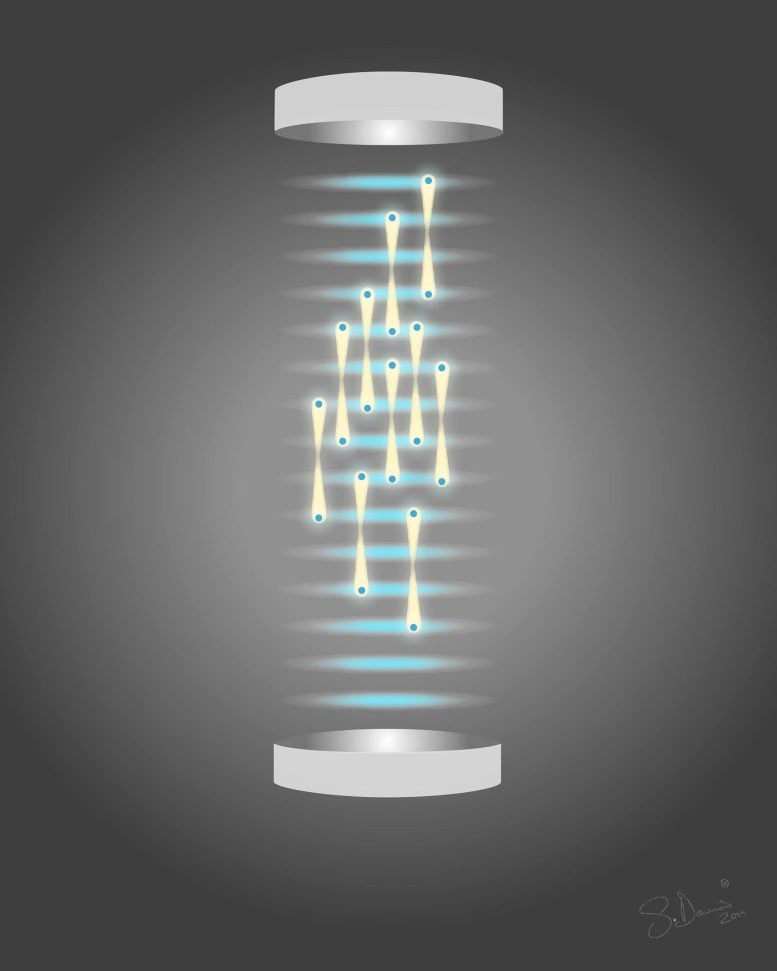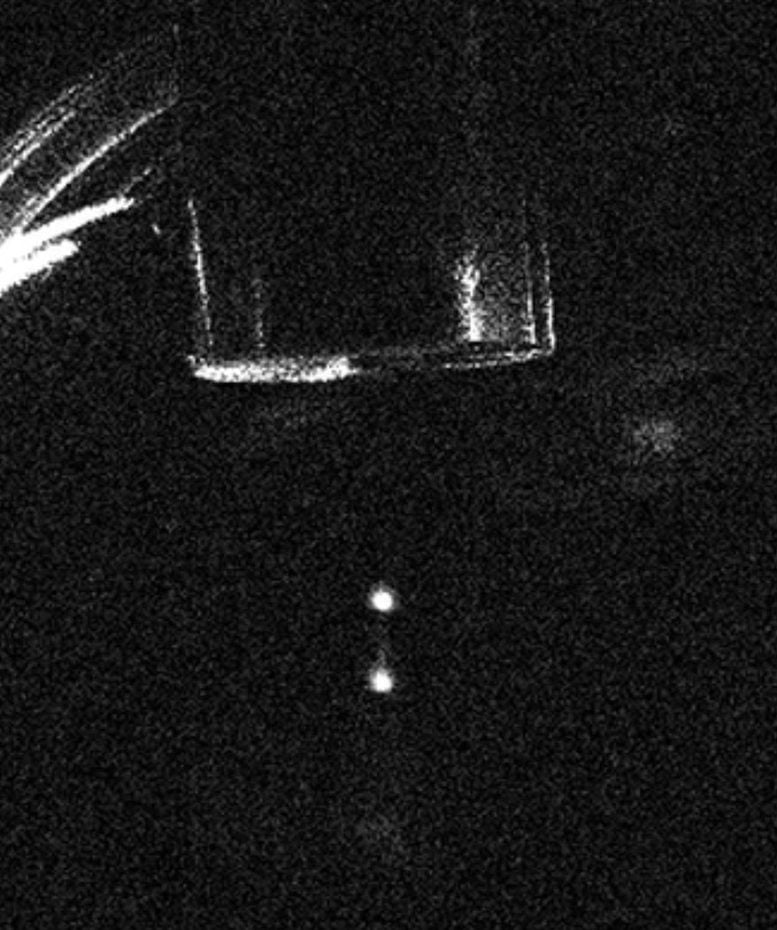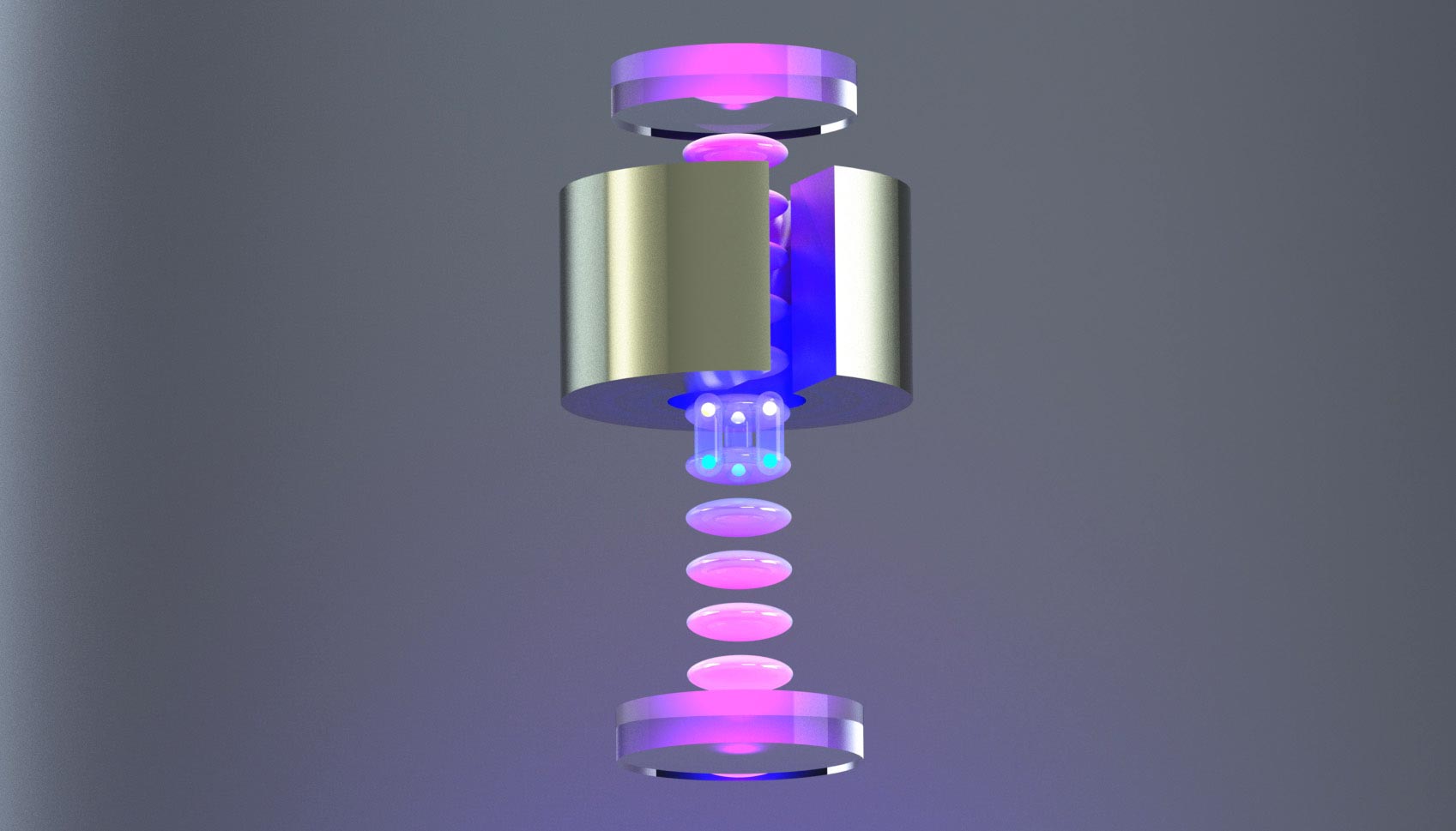Physicists at UC Berkeley immobilized small clusters of cesium atoms (pink blobs) in a vertical vacuum chamber, then split each atom into a quantum state in which half of the atom was closer to a tungsten weight (shiny cylinder) than the other half (split spheres below the tungsten). By measuring the phase difference between the two halves of the atomic wave function, they were able to calculate the difference in the gravitational attraction between the two parts of the atom, which matched what is expected from Newtonian gravity. Credit: Cristian Panda/UC Berkeley
Experiment captures atoms in free fall to look for gravitational anomalies caused by the Universe’s missing energy.
Researchers at UC Berkeley have enhanced the precision of gravity experiments using an 
The purple glow of an infrared laser illuminates the optical bench used in the experiment. The laser is used to precisely control the quantum states of cesium atoms in a vacuum chamber. Credit: Holger Müller lab
Exploring the Quantum Nature of Gravity
Though the researchers found no deviation from what is predicted by the theory spelled out by Isaac Newton 400 years ago, expected improvements in the precision of the experiment could eventually turn up evidence that supports or disproves theories of a hypothetical fifth force mediated by chameleons or symmetrons.
The ability of the lattice atom interferometer to hold atoms for up to 70 seconds — and potentially 10 times longer — also opens up the possibility of probing gravity at the quantum level, said Holger Müller, UC Berkeley professor of physics. While physicists have well-tested theories describing the quantum nature of three of the four forces of nature — electromagnetism and the strong and weak forces — the quantum nature of gravity has never been demonstrated.
“Most theorists probably agree that gravity is quantum. But nobody has ever seen an experimental signature of that,” Müller said. “It’s very hard to even know whether gravity is quantum, but if we could hold our atoms 20 or 30 times longer than anyone else, because our sensitivity increases with the second or fourth power of the hold time, we could have a 400 to 800,000 times better chance of finding experimental proof that gravity is indeed quantum mechanical.”

An optical lattice traps groups of atoms (blue disks) in a regular array so that they can be studied for more than a minute inside a lattice atom interferometer. Individual atoms (blue dots) are placed in a quantum spatial superposition, that is, in two layers of the lattice at once, indicated by the elongated yellow bands. Credit: Sarah Davis
Applications and Future Directions in Quantum Sensing
Aside from precision measurements of gravity, other applications of the lattice atom interferometer include quantum sensing.
“Atom interferometry is particularly sensitive to gravity or inertial effects. You can build gyroscopes and accelerometers,” said UC Berkeley postdoctoral fellow Cristian Panda, who is first author of a paper about the gravity measurements set to be published this week in the journal Nature and is co-authored by Müller. “But this gives a new direction in atom interferometry, where quantum sensing of gravity, acceleration and rotation could be done with atoms held in optical lattices in a compact package that is resilient to environmental imperfections or noise.”
Because the optical lattice holds atoms rigidly in place, the lattice atom interferometer could even operate at sea, where sensitive gravity measurements are employed to map the geology of the ocean floor.
Insights Into Dark Energy and the Chameleon Particle
Dark energy was discovered in 1998 by two teams of scientists: a group of physicists based at Lawrence Berkeley National Laboratory, led by Saul Perlmutter, now a UC Berkeley professor of physics, and a group of astronomers that included UC Berkeley postdoctoral fellow Adam Riess. The two shared the 2011 Nobel Prize in Physics for the discovery.
The realization that the universe was expanding more rapidly than it should came from tracking distant supernovas and using them to measure cosmic distances. Despite much speculation by theorists about what’s actually pushing space apart, dark energy remains an enigma — a large enigma, since about 70% of the entire matter and energy of the universe is in the form of dark energy.

In this photograph, clusters of about 10,000 cesium atoms can be seen floating in a vacuum chamber, levitated by crossed laser beams that create a stable optical lattice. A cylindrical tungsten weight and its support are visible at the top. Credit: Cristian Panda, UC Berkeley
One theory is that dark energy is merely the vacuum energy of space. Another is that it is an energy field called quintessence, which varies over time and space.
Another proposal is that dark energy is a fifth force much weaker than gravity and mediated by a particle that exerts a repulsive force that varies with the density of surrounding matter. In the emptiness of space, it would exert a repulsive force over long distances, able to push space apart. In a laboratory on Earth, with matter all around to shield it, the particle would have an extremely small reach.
This particle has been dubbed a chameleon, as if it’s hiding in plain sight.
Advances in Atom Interferometry Techniques
In 2015, Müller adapted an atom interferometer to search for evidence of chameleons using cesium atoms launched into a vacuum chamber, which mimics the emptiness of space. During the 10 to 20 milliseconds it took the atoms to rise and fall above a heavy aluminum sphere, he and his team detected no deviation from what would be expected from the normal gravitational attraction of the sphere and Earth.
The key to using free-falling atoms to test gravity is the ability to excite each atom into a quantum superposition of two states, each with a slightly different momentum that carries them different distances from a heavy tungsten weight hanging overhead. The higher momentum, higher elevation state experiences more gravitational attraction to the tungsten, changing its phase. When the atom’s wave function collapses, the phase difference between the two parts of the matter wave reveals the difference in gravitational attraction between them.
“Atom interferometry is the art and science of using the quantum properties of a particle, that is, the fact that it’s both a particle and a wave. We split the wave up so that the particle is taking two paths at the same time and then interfere them at the end,” Müller said. “The waves can either be in phase and add up, or the waves can be out of phase and cancel each other out. The trick is that whether they are in phase or out of phase depends very sensitively on some quantities that you might want to measure, such as acceleration, gravity, rotation or fundamental constants.”
Extending the Boundaries of Experimental Physics
In 2019, Müller and his colleagues added an optical lattice to keep the atoms close to the tungsten weight for a much longer time — an astounding 20 seconds — to increase the effect of gravity on the phase. The optical lattice employs two crossed laser beams that create a lattice-like array of stable places for atoms to congregate, levitating in the vacuum. But was 20 seconds the limit, he wondered?
During the height of the published those results in the June 11, 2024, issue of sensitive enough to detect the quantum properties of gravity. The planned experiment to detect gravitational entanglement, if successful, would be akin to the first demonstration of quantum entanglement of photons performed at UC Berkeley in 1972 by the late Stuart Freedman and former postdoctoral fellow John Clauser. Clauser shared the 2022 Nobel Prize in Physics for that work.
Reference: “Measuring gravitational attraction with a lattice atom interferometer” by Cristian D. Panda, Matthew J. Tao, Miguel Ceja, Justin Khoury, Guglielmo M. Tino and Holger Müller, 26 June 2024, Nature.
DOI: 10.1038/s41586-024-07561-3
Other co-authors of the gravity paper are graduate student Matthew Tao and former undergraduate student Miguel Ceja of UC Berkeley, Justin Khoury of the











/https://tf-cmsv2-smithsonianmag-media.s3.amazonaws.com/filer_public/34/31/3431771d-41e2-4f97-aed2-c5f1df5295da/gettyimages-1441066266_web.jpg)








Discussion about this post